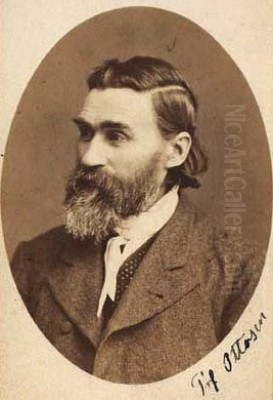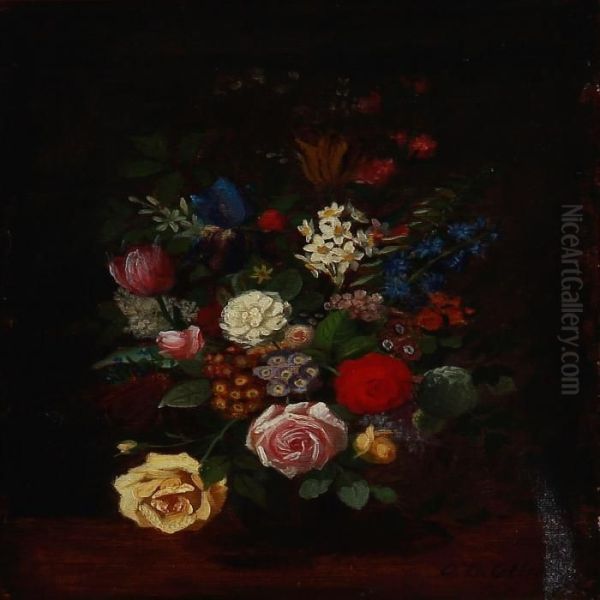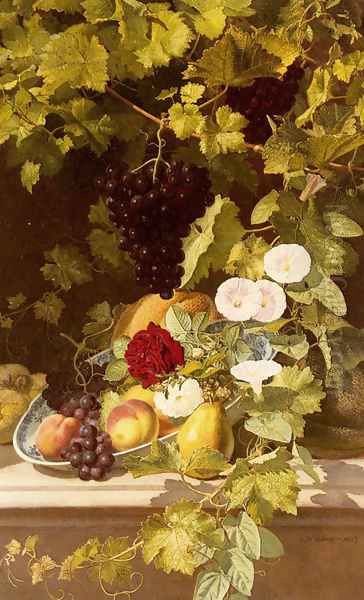
Otto Didrik Ottesen stands as a significant figure in 19th-century Danish art, particularly celebrated for his exquisite still life paintings, with a pronounced focus on flowers. Active during and after the period known as the Danish Golden Age, Ottesen developed a distinct style characterized by meticulous detail, botanical accuracy, and a deep appreciation for the beauty of the natural world. His work not only reflects the artistic currents of his time but also showcases a personal dedication to capturing the transient elegance of floral arrangements and the bounty of nature.
Early Life and Artistic Beginnings
Born on April 3, 1816, in Broager, Sønderjylland (South Jutland), Denmark, Otto Didrik Ottesen's journey into the world of art began relatively early. Like many aspiring artists of his generation, he gravitated towards Copenhagen, the cultural and artistic heart of the nation. There, he sought formal training to hone his innate talents. He enrolled at the prestigious Royal Danish Academy of Fine Arts (Det Kongelige Danske Kunstakademi), the central institution shaping Danish art during this era.
The Academy, under the influential leadership of figures like Christoffer Wilhelm Eckersberg, often referred to as the "Father of Danish Painting," emphasized rigorous training based on observation from life, classical principles, and technical proficiency. While Eckersberg's direct influence was more pronounced on the earlier Golden Age painters focusing on portraiture, landscape, and genre scenes, the Academy's overall ethos of careful study and realistic representation undoubtedly shaped Ottesen's approach, even as he chose to specialize in the genre of still life.
The Context of the Danish Golden Age
Ottesen's formative years coincided with the flourishing of the Danish Golden Age, roughly spanning the first half of the 19th century. This period witnessed an extraordinary blossoming of arts and sciences in Denmark, partly fueled by a sense of national identity following challenging times, including the Napoleonic Wars and the loss of Norway. Artists sought to depict Danish landscapes, people, and daily life with a sense of intimacy, realism, and quiet dignity.

Key figures of the Golden Age included painters like Christen Købke, known for his sensitive portraits and views of Copenhagen's outskirts; Martinus Rørbye, who traveled widely but also captured Danish scenes with clarity; Wilhelm Bendz, a master of genre scenes and portraits; Constantin Hansen, famed for his Italian scenes and portraits of Copenhagen's intellectual elite; and landscape painters such as Johan Thomas Lundbye and Peter Christian Skovgaard, who romanticized the Danish countryside. While Ottesen's primary focus differed, he operated within this milieu that valued detailed observation and technical skill.
Specialization in Floral Painting
While the Golden Age saw diverse genres flourish, still life, particularly flower painting, held a special place. Building on a tradition influenced by 17th-century Dutch masters, Danish artists brought their own sensibility to the genre. Ottesen emerged as one of the most accomplished flower painters of his generation, following in the footsteps of the slightly older, highly influential J.L. Jensen, who is often considered the preeminent Danish flower painter of the era.
Ottesen developed a remarkable ability to render flowers with almost scientific precision, capturing the unique texture of petals, the subtle variations in color, and the play of light on leaves and stems. His compositions often feature lush bouquets arranged in vases, showcasing a variety of species blooming simultaneously – a convention common in floral still lifes, prioritizing aesthetic harmony over strict botanical seasonality. He didn't just paint flowers; he celebrated their inherent beauty and fragility.
His technique involved careful layering of oil paint, often on panel or canvas, achieving smooth finishes and luminous effects. The attention to detail extended beyond the flowers themselves to include the vases, tabletops, and sometimes accompanying elements like fruits or insects, adding layers of interest and realism to his works. This meticulousness aligned with the broader Danish artistic emphasis on close study of the subject.
Representative Works
Several paintings stand out in Ottesen's oeuvre, exemplifying his skill and artistic vision. One notable example is Flowers in a Vase from 1869, now housed in the Statens Museum for Kunst (National Gallery of Denmark) in Copenhagen. This oil-on-wood painting (77 x 57 cm) presents a vibrant, overflowing bouquet featuring roses, tulips, lilies, and other flowers in a classical urn. The composition is rich and balanced, the colors are vivid yet harmonious, and the rendering of textures is masterful. It embodies the academic classicism and refined realism that characterized much of his work.

Another significant piece mentioned is Still Life with Meat, Vegetables, and Apples (1876). While primarily known for flowers, this work demonstrates Ottesen's versatility within the still life genre. It reportedly features a variety of fruits (melons, grapes, apples, pears, plums, cherries) alongside vegetables and meat. Such compositions allowed artists to showcase their skill in depicting diverse textures, forms, and colors, often carrying symbolic meanings related to abundance, transience, or the pleasures of the table. The description suggests a focus on detailed realism and potentially dramatic lighting, reminiscent of earlier Dutch and Flemish traditions.
Throughout his career, Ottesen produced numerous variations on these themes, consistently delivering works of high technical quality and aesthetic appeal. His paintings often depict roses, peonies, tulips, carnations, and other popular garden flowers, arranged with an eye for balance and visual delight.
Travels and Broadening Horizons
Like many artists seeking inspiration and exposure to different traditions, Ottesen traveled beyond Denmark. Sources indicate he visited the Netherlands, France, and Switzerland. These journeys would have been significant opportunities for his artistic development. In the Netherlands, he could study the works of the legendary Dutch Golden Age flower painters like Jan van Huysum or Rachel Ruysch firsthand, observing their techniques and compositional strategies.
France, particularly Paris, was the epicenter of European art in the 19th century. Exposure to French academic painting, and perhaps the emerging currents that would lead to Impressionism (though Ottesen remained largely committed to a more traditional style), could have subtly influenced his palette or approach. Switzerland offered dramatic landscapes, which, while not his primary subject, might have broadened his appreciation for natural forms and light. These travels likely enriched his visual vocabulary and reinforced his commitment to realism, while also connecting him to the broader European art scene.
Academic Recognition and Career Success
Ottesen's dedication and skill did not go unnoticed within the Danish art establishment. He became a member of the Royal Danish Academy of Fine Arts in 1866, a significant honor indicating recognition by his peers. His standing continued to grow, and in 1874, he was awarded the title of Professor at the Academy, signifying his esteemed position within the institution responsible for training the next generation of artists.
Furthermore, in 1887, he became a member of the Academy Council (Akademirådet), the governing body of the Academy, placing him in a position of influence within the Danish art world. He was a regular exhibitor at the prestigious Charlottenborg Spring Exhibition in Copenhagen, the main venue for established and emerging artists to showcase their work to the public and critics. His consistent participation and the accolades he received cemented his reputation as a leading still life painter. His works were acquired by collectors and institutions, ensuring their preservation and visibility.
Contemporaries and the Danish Art Scene
Beyond the major figures of the Golden Age, Ottesen interacted with and worked alongside numerous other artists. The field of flower painting in Denmark included talented women artists who gained recognition despite the challenges they faced in accessing formal training and exhibition opportunities comparable to men. Among those mentioned as contemporaries are Hermania Neergaard, Hanne Hellesen, and Christine Løvmand. These artists also contributed significantly to the tradition of floral and still life painting in Denmark.
Other Danish artists active during Ottesen's long career include landscape painters like Vilhelm Kyhn, genre painters such as Julius Exner, and the Skagen Painters like Michael Ancher and Anna Ancher who emerged later in Ottesen's life, representing a shift towards Realism and Plein Air painting. While Ottesen's style remained rooted in the detailed realism associated with the Golden Age legacy and academic tradition, he was part of a dynamic and evolving national art scene. His contemporaries might also include figures like Carl Bloch, known for his historical and religious paintings, and Kristian Zahrtmann, who pushed boundaries with his historical subjects and bold use of color.
Later Life and Legacy
Otto Didrik Ottesen continued to paint throughout his life, remaining dedicated to his chosen genre. He lived through a period of significant change in European art, witnessing the rise of Realism, Impressionism, and Post-Impressionism. However, his own style maintained a consistent focus on meticulous rendering, balanced compositions, and the celebration of natural beauty, particularly flowers. This adherence to a more traditional aesthetic ensured his popularity with patrons who appreciated technical skill and conventional subjects.
He passed away in 1892, leaving behind a substantial body of work that continues to be admired for its technical brilliance and aesthetic charm. His paintings are held in major Danish museums, including the Statens Museum for Kunst, and appear in private collections and auctions, attesting to their enduring appeal.
Ottesen's legacy lies in his mastery of floral still life painting within the Danish context. He successfully carried forward the tradition of detailed observation and technical refinement associated with the Danish Golden Age, applying it with particular focus and sensitivity to the world of flowers. While perhaps overshadowed internationally by the landscape and genre painters of the Golden Age, or by the later Skagen Painters, Ottesen remains a key figure for understanding the depth and diversity of 19th-century Danish art.
Personal Life
Details about Ottesen's personal life are less documented than his artistic career, but sources suggest a life centered around his work and family. It is mentioned that he married three times. Records associated with places like Haan and the Abel Cathrine Foundation (Abel Cathrines Stiftelse, a housing foundation in Copenhagen) might relate to his marriages or family circumstances. He is also noted as having three sons. While the specifics remain somewhat unclear from the provided summary, these details paint a picture of a man navigating personal life alongside a demanding artistic career. His primary residence and place of work for much of his life appears to have been Copenhagen, the hub of his professional activities. His long life, spanning from 1816 to 1892, allowed him to witness significant transformations in Danish society and art.
Conclusion: An Enduring Appreciation for Nature's Beauty
Otto Didrik Ottesen carved a distinct niche for himself within the rich tapestry of Danish art. As a preeminent painter of flowers and still lifes, he combined the meticulous realism championed by the Royal Danish Academy with a genuine sensitivity to the natural world. His works are more than mere botanical illustrations; they are carefully composed celebrations of color, form, and light, capturing the ephemeral beauty of flowers with enduring skill. Situated within the context of the Danish Golden Age and its aftermath, and working alongside contemporaries like J.L. Jensen, Hermania Neergaard, and Christine Løvmand, Ottesen contributed significantly to the strength of still life painting in Denmark. His academic recognition and the lasting appeal of his paintings confirm his status as a master of his genre, whose dedication to depicting nature's bounty continues to resonate with viewers today.